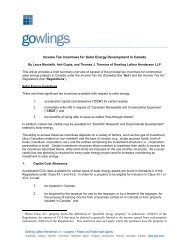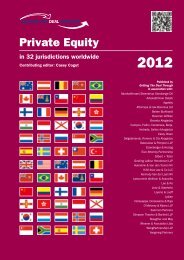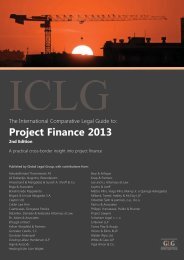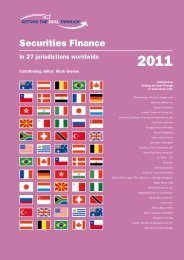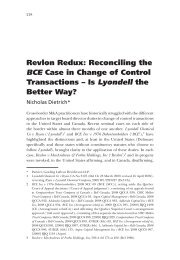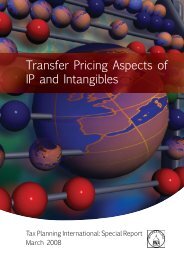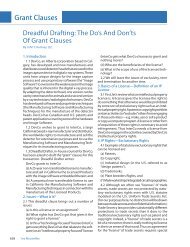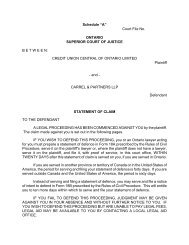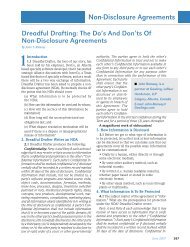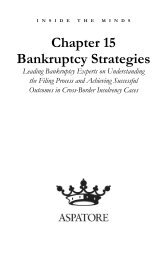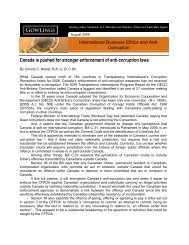Consolidated Wage Earner Protection Program Act and ... - Gowlings
Consolidated Wage Earner Protection Program Act and ... - Gowlings
Consolidated Wage Earner Protection Program Act and ... - Gowlings
- No tags were found...
You also want an ePaper? Increase the reach of your titles
YUMPU automatically turns print PDFs into web optimized ePapers that Google loves.
<strong>Consolidated</strong> <strong>Wage</strong> <strong>Earner</strong> <strong>Protection</strong> <strong>Program</strong> <strong>Act</strong> <strong>and</strong> <strong>Wage</strong> <strong>Earner</strong> <strong>Protection</strong> <strong>Program</strong> Regulationsreceiver or receiver-manager 7 .Benefits are not specifically referenced in the WEPPA or the WEPP Regulations 8 . However, in Re Ted LeroyTrucking Ltd. 9 , the British Columbia Supreme Court considered whether the WEPP included coverage forpayments that an employee has directed be paid to a third party or that are payable by the employer to a thirdparty on that employee's behalf pursuant to an agreement. The Court found that the reasonable definition of“compensation for services rendered” in the definition of “wages” must mean all compensation earned by theemployee <strong>and</strong> cannot be limited to only that portion of the compensation earned by the employee <strong>and</strong> due tobe paid directly to the employee, as opposed to being paid to third parties at the direction of <strong>and</strong> for thebenefit of the employee <strong>and</strong> included all employee benefits <strong>and</strong> entitlements. The Court reasoned that,regardless of whether each of these items may be considered "wages" in the ordinary sense of the word, theyare clearly "returns given by an employer to or for the benefit of the employee for services given by theemployee" <strong>and</strong> are properly viewed as compensation for services performed by the employee.Where the bankruptcy or receivership of an employer occurs on or after January 27, 2009, the employees whoare terminated will be able to make a claim under the WEPP for termination <strong>and</strong> severance pay. The BudgetImplementation <strong>Act</strong>, 2009, exp<strong>and</strong>ed the WEPP, effective January 27, 2009, to include severance pay <strong>and</strong>termination pay 10 that relates to employment that ended during the six months prior to the date ofbankruptcy or the first date that a receiver was appointed in respect of the employer 11 .Termination pay is the amount that an employer is required to pay to a terminated employee in lieu of thestatutory notice of termination. An employer can terminate the employment of an employee without writtennotice or with less notice than is required by the applicable legislation if the employer pays termination pay tothe employee. Severance pay, on the other h<strong>and</strong>, is additional statutory compensation that, depending on theapplicable legislation, may be paid to a terminated employee.The quantum of the termination pay payable to an employee, <strong>and</strong> whether severance pay is owing to theemployee <strong>and</strong>, if so, the amount of that severance pay, will depend on the applicable Federal or Provincialstatutory regime 12 .Under the Employment St<strong>and</strong>ards <strong>Act</strong>, 2000 (Ontario) 13 , an employer is required to provide employees who areterminated “without cause” with a minimum period of notice or pay in lieu of notice that depends on thenumber of employees being terminated, the size of the employer’s payroll <strong>and</strong> the employee’s length ofservice 14 . In lieu of the required notice, the employer may: (a) pay to the employee termination pay equal tothe lump sum equal to the amount the employee would have been entitled to receive had notice been given;<strong>and</strong> (b) continue to make whatever benefit plan contributions would be required to be made in order tomaintain the benefits to which the employee would have been entitled had the employee continued to be7 Subsection 243(2) of the BIA will be amended by 2007, c. 36, s. 58(1). This legislation is not yet in force. The WEPPA uses the phrase “subject to a receivership” in a number of places <strong>and</strong> WEPPA s. 2(2) provides that an employer is “subject to a receivership” when “any of the property of the employer is under the possession or control of a receiver”. This creates an interesting interpretation issue since s. 243(2) of the BIA definition refers to taking possessionof “all of substantially all” of the debtor’s inventory, accounts receivable or other property. 8 Service Canada’s website advises the benefits are not covered by the WEPP. 9 2009 CarswellBC 98 (S.C.). 10 The intention appears to be that the WEPP will provide coverage for statutory termination <strong>and</strong> severance pay<strong>and</strong> not for any damages that might be awarded to an employee were the employee to sue the debtor for wrongfuldismissal. 11 The Budget Implementation <strong>Act</strong> 2009, s. 342. Section 3 of the WEPP Regulations establishes the circumstances when an employee’s employment is deemed to be terminated for the purpose of s. 5 of the WEPP. This section of the WEPP Regulations does not apply to WEPPA, s. 2(1)(b).12 It does not appear that the WEPP is intended to cover common law damages for wrongful termination. 13 S.O. 2000, Chap. 41 (the “ESA, 2000”). 14 ESA, 2000, s. 57, 58 <strong>and</strong> 64. Page 3
<strong>Consolidated</strong> <strong>Wage</strong> <strong>Earner</strong> <strong>Protection</strong> <strong>Program</strong> <strong>Act</strong> <strong>and</strong> <strong>Wage</strong> <strong>Earner</strong> <strong>Protection</strong> <strong>Program</strong> Regulationsclaim that the trustee or receiver has to be reimbursed out of the bankruptcy estate or the property of thedebtor will be subordinate to priority claims such as statutory deemed trusts, statutory charges <strong>and</strong> securedclaims.The WEPP Regulations provide for circumstances in which the Minister will pay the fees <strong>and</strong> expenses inrelation to the WEPP 49 . The circumstances where the Minister will pay fees <strong>and</strong> expenses are limited. TheMinister will not, for example, pay fees <strong>and</strong> expenses where the trustee or receiver has received a guarantee inrespect of fees <strong>and</strong> expenses from a creditor 50 .III.Employee Remuneration ChargeSections 81.3 <strong>and</strong> 81.4 of the BIA create a charge over a debtor’s “current assets” 51 in favour of employees –the “ERC” – to secure wages, salaries, commissions, or other compensation of up to $2,000 owing toemployees <strong>and</strong> disbursements of up to $1,000 owing to travelling salespeople by a person who is subject to areceivership or who is bankrupt 52 . The ERC covers amounts owing: (a) in the case of a receivership, duringthe six months before the date the receiver was appointed; or (b) in the case of a bankruptcy, the periodbeginning on the day that is six months before the date of the initial bankruptcy event <strong>and</strong> ending on the dateof the bankruptcy 53 . The ERC does not secure termination or severance pay 54 .The ERC is a statutory charge in favour of employees that is different from the benefits that employees mayclaim under the WEPP.While the coverage provided by the ERC <strong>and</strong> the WEPP overlap, there are differences between the ERC <strong>and</strong>the WEPP in terms of coverage. The WEPP provides coverage for termination pay <strong>and</strong> severance pay as wellas employee remuneration <strong>and</strong> covers a global amount of up to $3,000. The ERC, on the other h<strong>and</strong>, securesup to $2,000 for employee remuneration (termination pay <strong>and</strong> severance pay are not secured by the ERC) <strong>and</strong>up to $1,000 for disbursements.The WEPP <strong>and</strong> the ERC also differ in terms of the period covered <strong>and</strong>, it appears, eligibility for coverage.The WEPP provides coverage for remuneration earned during the six months prior to the date of bankruptcyor the first date that a receiver was appointed in respect of the employer. The ERC, on the other h<strong>and</strong>,secures amounts owing (a) in the case of a bankruptcy, in respect of the period beginning six months prior tothe date of the initial bankruptcy event <strong>and</strong> ending on the date of bankruptcy; <strong>and</strong> (b) where a receiver isappointed, in respect of the six months prior to the appointment of the receiver. The key difference is in thecase of a bankruptcy where the ERC appears to provide broader coverage than the WEPP. (See attachedchart)The ERC will not secure claims by a debtor company’s officers <strong>and</strong> directors <strong>and</strong> persons who did not dealwith the debtor at arms length will only be entitled to the ERC if the trustee or receiver is of the opinion thatthe employment contract between the debtor <strong>and</strong> the non arms length party was on arms length terms. As49 WEPP Regulations, s. 18 <strong>and</strong> 19. 50 WEPP Regulations, s. 18(1)(c).51 Note that the definition of “current assets” is not yet in force. The intention is, however, that the ERC will attach only to cash, cash equivalents, including negotiable instruments <strong>and</strong> dem<strong>and</strong> deposits, inventory or accountsreceivable, <strong>and</strong> the proceeds from any dealing with those assets. 52 Amendments to the BIA <strong>and</strong> the CCAA that will increase the protection afforded to employees in reorganization proceedings have been passed, but not yet proclaimed in force. 53 BIA, s. 81.3 <strong>and</strong> 81.4.54 BIA, s. 81.3(9) <strong>and</strong> 81.4(9). See Re Ted Leroy Trucking Ltd., 2009 CarswellBC 98 (S.C.) with respect to whether benefits are covered by the ERC. Page 8
<strong>Consolidated</strong> <strong>Wage</strong> <strong>Earner</strong> <strong>Protection</strong> <strong>Program</strong> <strong>Act</strong> <strong>and</strong> <strong>Wage</strong> <strong>Earner</strong> <strong>Protection</strong> <strong>Program</strong> Regulationsmentioned above, a broader category of employees appear to be excluded from the WEPP.The only true “linkages” between the ERC <strong>and</strong> the WEPP are: (a) where the ERC <strong>and</strong> the WEPP providecoverage for the same amounts, the employee cannot recover this amount under both the ERC <strong>and</strong> theWEPP 55 ; <strong>and</strong> (b) where an employee recovers under the WEPP an amount that would otherwise be securedby the ERC, the Crown subrogates to the employee’s rights as a secured creditor under the ERC 56 .March, 2009Toronto, Canada55 WEPPA, s. 7(1) <strong>and</strong> WEPP Regulations, s. 6 create a setoff from the WEPP payment an employee is entitledto receive for eligible wages received after a bankruptcy or the appointment of a receiver <strong>and</strong> WEPP Regulations, s. 8allocates payments received under the WEPP to wages <strong>and</strong> vacation pay in priority to termination <strong>and</strong> severance pay. If,however, an employee’s claim for wages <strong>and</strong> vacation is paid in full prior to a bankruptcy or the appointment of areceiver, in the course of a reorganization proceeding for example, the employee may make a claim against the WEPPfor termination pay <strong>and</strong>, if applicable, severance pay only thereby maximizing the employee’s recovery in the insolvencyproceedings without necessarily adversely impacting secured creditor recoveries.56 WEPPA, s. 36(1).Page 9
<strong>Consolidated</strong> <strong>Wage</strong> <strong>Earner</strong> <strong>Protection</strong> <strong>Program</strong> <strong>Act</strong> <strong>and</strong> <strong>Wage</strong> <strong>Earner</strong> <strong>Protection</strong> <strong>Program</strong> RegulationsCOMPARISON OF KEY AMENDMENTSJuly 7, 2008 – January 26, 2009 January 27, 2009 –CoverageWEPPA, s. 2(1) <strong>and</strong> WEPPRegulations, s. 2.Termination of EmploymentWEPP Regulations, s. 3.OffsetsWEPP Regulations, s. 6(a).Allocation of PaymentsWEPP Regulations, s. 8.Includes salaries, commissions,compensation for servicesrendered, vacation pay, gratuitiesaccounted for by the employer,disbursements of a travelingsalesperson properly incurred in<strong>and</strong> about the business of abankrupt or the business of aperson subject to a receivership,production bonuses <strong>and</strong> shiftpremiumsIf there is a period of at leastseven consecutive days duringwhich no work is performed forthe employer <strong>and</strong> during which nowages are payable.Any amount that the individualhas received under s. 81.3 or 81.4of the Bankruptcy <strong>and</strong> Insolvency <strong>Act</strong>.1. <strong>Wage</strong>s.2. Disbursements of a travellingsalesperson.3. Vacation pay.Includes salaries, commissions,compensation for servicesrendered, vacation pay, severancepay, termination pay, gratuitiesaccounted for by the employer,disbursements of a travelingsalesperson properly incurred in<strong>and</strong> about the business of abankrupt or the business of aperson subject to a receivership,production bonuses <strong>and</strong> shiftpremiumsIf it has ended because: (a) theindividual resigned or retired; (b)the individual’s employment hasterminated; or (c) the termof the individual’s employmenthas expired.Any amount that the individualhas received after the date of thebankruptcy or the first day onwhich there was a receiver inrelation to the former employer byvirtue of his or her rights inrespect of the eligible wages.1. <strong>Wage</strong>s.2. Disbursements of a travellingsalesperson.3. Vacation pay.4. Termination pay.5. Severance pay.Page 10
<strong>Consolidated</strong> <strong>Wage</strong> <strong>Earner</strong> <strong>Protection</strong> <strong>Program</strong> <strong>Act</strong> <strong>and</strong> <strong>Wage</strong> <strong>Earner</strong> <strong>Protection</strong> <strong>Program</strong> RegulationsCLAIM PROCESSCLAIM FILED BYINDIVIDUALACCEPTEDBY MINISTERYESNOPAYMENT MADE TOEMPLOYEEREQUESTFOR REVIEWYESNOMINISTER CAN CONFIRMVARY OR RESCINDDETERMINATIONMATTER FINALIZED ANDNOT SUBJECT TOQUESTIONING OR REVIEWIN ANY COURTVARIANCENON-VARIANCEPAYMENT TOEMPLOYEE THEAMOUNT RESULTINGFROM THE VARIANCEAPPEAL(IN WRITING)YESNOVARY REVIEWCONFIRM, VARYOR RESCIND THEDECISIONDECISION AT REVIEW FINALAND MAY NOT BE REVIEWEDOR QUESTIONED BY ANYCOURTMAKE PAYMENTDECISION FINAL AND MAYNOT BE QUESTIONED IN ANYCOURTPage 11
<strong>Consolidated</strong> <strong>Wage</strong> <strong>Earner</strong> <strong>Protection</strong> <strong>Program</strong> <strong>Act</strong> <strong>and</strong> <strong>Wage</strong> <strong>Earner</strong> <strong>Protection</strong> <strong>Program</strong> RegulationsCOVERAGE COMPARISON CHART BANKRUPTCYEmployee Remuneration ChargeInitial Bankruptcy EventBankruptcy6 monthsCoverage (max $2,000 + $1,000 for Salespersons)WEPPBankruptcy6 monthsCoverage (max $3,000 +)RECEIVERSHIPEmployee Remuneration ChargeAppointment6 monthsCoverage (max $2,000 + $1,000 for Salespersons)WEPPAppointment6 monthsCoverage (max $3,000 +)Page 12
<strong>Consolidated</strong> <strong>Wage</strong> <strong>Earner</strong> <strong>Protection</strong> <strong>Program</strong> <strong>Act</strong> <strong>and</strong> <strong>Wage</strong> <strong>Earner</strong> <strong>Protection</strong> <strong>Program</strong> RegulationsWAGE EARNER PROTECTION PROGRAM ACT 57S.C. 2005, c. 47, s. 1An <strong>Act</strong> to establish a program for making payments to individuals in respect of wages owed to them byemployers who are bankrupt or subject to a receivershipSHORT TITLE1. Short title — This <strong>Act</strong> may be cited as the <strong>Wage</strong> <strong>Earner</strong> <strong>Protection</strong> <strong>Program</strong> <strong>Act</strong>.INTERPRETATION2. (1) Definitions — The following definitions apply in this <strong>Act</strong>. “eligible wages” means (a) wages other than severance pay <strong>and</strong> termination pay that were earned during the six-month periodending on the date of the bankruptcy or the first day on which there was a receiver in relation to theformer employer; <strong>and</strong>(b) severance pay <strong>and</strong> termination pay that relate to employment that ended during the period referred toin paragraph (a).“wages” includes salaries, commissions, compensation for services rendered, vacation pay, severance pay,termination pay <strong>and</strong> any other amounts prescribed by regulation. [2009, c. 2, s. 342]Where the employer became bankrupt or the receiver was appointed between July 7, 2008 <strong>and</strong>January 26, 2009, subsection 2(1) reads:2. (1) Meaning of “wages” — In this <strong>Act</strong>, “wages” includes salaries, commissions, compensation forservices rendered, vacation pay <strong>and</strong> any other amounts prescribed by regulation but does not includeseverance or termination pay.(2) Employers subject to a receivership — For the purposes of this <strong>Act</strong>, an employer is subject to areceivership when any property of the employer is under the possession or control of a receiver.(3) Meaning of “receiver”— In this <strong>Act</strong>, “receiver” means a receiver within the meaning of subsection243(2) of the Bankruptcy <strong>and</strong> Insolvency <strong>Act</strong>.57 Reflects amendments made by S.C. 2007, c. 36 <strong>and</strong> S.C. 2009, c. 2. The <strong>Wage</strong> <strong>Earner</strong> <strong>Protection</strong> <strong>Program</strong> <strong>Act</strong> cameinto force on July 7, 2008 <strong>and</strong> applies in respect of wages owing by an employer if: (a) the employer became bankrupt onor after July 7, 2008; or (b) any of the employer’s property came into the possession or under the control of a receiver,within the meaning of the Bankruptcy <strong>and</strong> Insolvency <strong>Act</strong>, on or after July 7, 2008. The <strong>Wage</strong> <strong>Earner</strong> <strong>Protection</strong> <strong>Program</strong> <strong>Act</strong>was amended by S.C. 2009, c. 2. Those amendments apply in respect of wages owing by an employer where: (a) theemployer became bankrupt after January 26, 2009; or (b) any of the employer’s property came into the possession orunder the control of a receiver, within the meaning of the Bankruptcy <strong>and</strong> Insolvency <strong>Act</strong>, after January 26, 2009. See S.C.2009, c. 2, s. 357.Page 13
<strong>Consolidated</strong> <strong>Wage</strong> <strong>Earner</strong> <strong>Protection</strong> <strong>Program</strong> <strong>Act</strong> <strong>and</strong> <strong>Wage</strong> <strong>Earner</strong> <strong>Protection</strong> <strong>Program</strong> Regulations(4) Words <strong>and</strong> expressions — Unless otherwise provided, words <strong>and</strong> expressions used in this <strong>Act</strong> havethe same meaning as in the Bankruptcy <strong>and</strong> Insolvency <strong>Act</strong>.(5) Related persons — Despite subsection 4(5) of the Bankruptcy <strong>and</strong> Insolvency <strong>Act</strong>,(a) for the purposes of paragraph 6(d), an individual is considered to deal at arm’s length with a relatedperson if the Minister is satisfied that, having regard to the circumstances — including the terms <strong>and</strong>conditions of the individual’s employment with the former employer, their remuneration <strong>and</strong> theduration, nature <strong>and</strong> importance of the work performed for the former employer — it is reasonableto conclude that the individual would have entered into a substantially similar contract ofemployment with the former employer if they had been dealing with each other at arm’s length; <strong>and</strong>(b) for the purposes of subsection 21(4), individuals who are related to each other are, in the absence ofevidence to the contrary, deemed not to deal with each other at arm’s length while so related.[2007, c. 36, s. 83]DESIGNATION OF MINISTER3. Power of Governor in Council — The Governor in Council may designate a member of the Queen’sPrivy Council for Canada to be the Minister for the purposes of this <strong>Act</strong>.PROGRAM ESTABLISHED4. Establishment — The <strong>Wage</strong> <strong>Earner</strong> <strong>Protection</strong> <strong>Program</strong> is established to make payments toindividuals in respect of wages owed to them by employers who are bankrupt or subject to a receivership.ELIGIBILITY FOR PAYMENTS5. Conditions of eligibility — An individual is eligible to receive a payment if(a) the individual’s employment ended for a reason prescribed by regulation; [2009, c. 2, s. 343(1)](b) the former employer is bankrupt or subject to a receivership; <strong>and</strong>(c) the individual is owed eligible wages by the former employer. [2009, c. 2, s. 343(2)]Where the employer became bankrupt or the receiver was appointed between July 7, 2008 <strong>and</strong>January 26, 2009, section 5 reads:5. Conditions of eligibility — An individual is eligible to receive a payment if(a) the individual’s employment terminated in the circumstances prescribed by regulation; [2007, c. 36,s. 84](b) the former employer is bankrupt or subject to a receivership;(c) the individual is owed wages by the former employer; <strong>and</strong>(d) the wages that are owed were earned during the six months immediately before the date of thePage 14
<strong>Consolidated</strong> <strong>Wage</strong> <strong>Earner</strong> <strong>Protection</strong> <strong>Program</strong> <strong>Act</strong> <strong>and</strong> <strong>Wage</strong> <strong>Earner</strong> <strong>Protection</strong> <strong>Program</strong> Regulationsbankruptcy or the first day on which there was a receiver in relation to the former employer.6. Exceptions — An individual is not eligible to receive a payment in respect of any wages earned during,or that otherwise relate to, a period in which the individual [2009, c. 2, s. 344](a) was an officer or director of the former employer;(b) had a controlling interest within the meaning of the regulations in the business of the formeremployer;(c) occupied a managerial position within the meaning of the regulations with the former employer; or(d) was not dealing at arm’s length with(i)an officer or director of the former employer,(ii) a person who had a controlling interest within the meaning of the regulations in the business ofthe former employer, or(iii) an individual who occupied a managerial position within the meaning of the regulations with theformer employer.[2007, c. 36, s. 85]Where the employer became bankrupt or the receiver was appointed between July 7, 2008 <strong>and</strong>January 26, 2009, section 6 reads:6. Exceptions — An individual is not eligible to receive a payment in respect of any wages earned duringa period in which the individual(a) was an officer or director of the former employer;(b) had a controlling interest within the meaning of the regulations in the business of the formeremployer;(c) occupied a managerial position within the meaning of the regulations with the former employer; or(d) was not dealing at arm’s length with(i)an officer or director of the former employer,(ii) a person who had a controlling interest within the meaning of the regulations in the business ofthe former employer, or(iii) an individual who occupied a managerial position within the meaning of the regulations with theformer employer.[2007, c. 36, s. 85]AMOUNTS COVERED BY PROGRAM7. (1) Amount of Payment — The amount that may be paid under this <strong>Act</strong> to an individual is theamount of eligible wages owing to the individual up to a maximum of the greater of the following amounts,less any amount prescribed by regulation:Page 15
<strong>Consolidated</strong> <strong>Wage</strong> <strong>Earner</strong> <strong>Protection</strong> <strong>Program</strong> <strong>Act</strong> <strong>and</strong> <strong>Wage</strong> <strong>Earner</strong> <strong>Protection</strong> <strong>Program</strong> Regulations(a) $3,000; <strong>and</strong>(b) an amount equal to four times the maximum weekly insurable earnings under the EmploymentInsurance <strong>Act</strong>.[2009, c. 2, s. 345](2) Bankruptcy <strong>and</strong> receivership — If the former employer is both bankrupt <strong>and</strong> subject to areceivership, the amount that may be paid is the greater of the amount determined in respect of thebankruptcy <strong>and</strong> the amount determined in respect of the receivership. [2009, c. 2, s. 345]Where the employer became bankrupt or the receiver was appointed between July 7, 2008 <strong>and</strong>January 26, 2009, section7 reads:7. (1) Amount of payment — The amount that may be paid under this <strong>Act</strong> to an individual is the amountowing to the individual for wages earned during the six months immediately before the date of thebankruptcy or the first day on which there was a receiver in relation to the former employer, as the case maybe, less any amount prescribed by regulation. In the case of a former employer who is both bankrupt <strong>and</strong>subject to a receivership, the amount owing is the greater of the amount determined in respect of thebankruptcy <strong>and</strong> the amount determined in respect of the receivership. [2007, c. 36, s. 86(1)](2) Maximum — The maximum amount that may be paid to an individual is the greater of the followingamounts, less any amount prescribed by regulation:(a) $3,000, <strong>and</strong>(b) an amount equal to four times the maximum weekly insurable earnings under the Employment Insurance<strong>Act</strong>;[2007, c. 36, s. 86(2) <strong>and</strong> (3)](3) Allocation of payments — Unless otherwise prescribed by regulation, payments made under this <strong>Act</strong>to an individual are to be allocated to vacation pay only after payments are first allocated to all othercomponents of wages owing to the individual.APPLICATION FOR PAYMENT8. Application — To receive a payment, an individual is to apply to the Minister in the manner <strong>and</strong>during the period provided for in the regulations. [2007, c. 36, s. 87]9. Minister’s determination of eligibility — If the Minister determines that the applicant is eligible toreceive a payment, the Minister shall make the payment. [2007, c. 36, s. 87]10. Notification — The Minister is to inform the applicant of their eligibility or ineligibility to receive apayment. [2007, c. 36, s. 87]REVIEW BY MINISTER11. Request for review — An applicant who is informed under section 10 may request a review of theireligibility or ineligibility, as the case may be. [2007, c. 36, s. 87]Page 16
<strong>Consolidated</strong> <strong>Wage</strong> <strong>Earner</strong> <strong>Protection</strong> <strong>Program</strong> <strong>Act</strong> <strong>and</strong> <strong>Wage</strong> <strong>Earner</strong> <strong>Protection</strong> <strong>Program</strong> Regulations12. Review — The Minister may confirm, vary or rescind a determination of eligibility made undersection 9. If the Minister varies the determination, the Minister shall make any payment resulting from thevariation. [2007, c. 36, s. 87]13. Review is final — Subject to the right of appeal under section 14, the Minister’s confirmation,variation or rescission, as the case may be, is final <strong>and</strong> may not be questioned or reviewed in any court. [2007,c. 36, s. 87]APPEAL TO ADJUDICATOR14. Appeal on question of law or jurisdiction — The applicant may appeal the decision made by theMinister under section 12 to an adjudicator only on a question of law or jurisdiction. [2007, c. 36, s. 87]15. Appointment of adjudicator — An appeal is to be heard by an adjudicator appointed by theMinister.16. Appeal on the record — The appeal is to be an appeal on the record <strong>and</strong> no new evidence isadmissible. [2007, c. 36, s. 88]17. Adjudicator’s decision — The adjudicator may confirm, vary or rescind the decision made by theMinister under section 12. If the adjudicator varies the decision, the Minister shall make any paymentresulting from the variation. [2007, c. 36, s. 88]18. Copies of decision — The adjudicator must send a copy of his or her decision, <strong>and</strong> the reasons for it,to each party to the appeal.19. No review by certiorari, etc. — No order may be made to review, prohibit or restrain <strong>and</strong> noprocess entered or proceeding taken to question, review, prohibit or restrain in any court — whether by wayof injunction, certiorari, prohibition, quo warranto or otherwise — an action of an adjudicator under this <strong>Act</strong>.[2007, c. 36, s. 89]20. Decision is final — The adjudicator’s decision is final <strong>and</strong> may not be questioned or reviewed in anycourt. [2007, c. 36, s. 89]ADMINISTRATIONDuties of Trustees <strong>and</strong> Receivers21. (1) General duties — For the purposes of this <strong>Act</strong>, a trustee or a receiver, as the case may be, shall(a) identify each individual who is owed eligible wages; [2009, c. 2, s. 346(1)](b) determine the amount of eligible wages owing to each individual; [2009, c. 2, s. 346(1)](c) inform each individual other than one who is in a class prescribed by regulation of the existence ofthe program established by section 4 <strong>and</strong> of the conditions under which payments may be madeunder this <strong>Act</strong>;Page 17
<strong>Consolidated</strong> <strong>Wage</strong> <strong>Earner</strong> <strong>Protection</strong> <strong>Program</strong> <strong>Act</strong> <strong>and</strong> <strong>Wage</strong> <strong>Earner</strong> <strong>Protection</strong> <strong>Program</strong> Regulations(d) provide the Minister <strong>and</strong> each individual other than one who is in a class prescribed by regulationwith the information prescribed by regulation in relation to the individual <strong>and</strong> with the amount ofeligible wages owing to the individual; <strong>and</strong> [2009, c. 2, s. 346(2)](e) inform the Minister of when the trustee is discharged or the receiver completes their duties, as thecase may be.[2007, c. 36, s. 89]Where the employer became bankrupt or the receiver was appointed between July 7, 2008 <strong>and</strong>January 26, 2009, subsection 21(1) reads:21. (1) General duties — For the purposes of this <strong>Act</strong>, a trustee or a receiver, as the case may be, shall(a) identify each individual who is owed wages that were earned during the six months immediatelybefore the date of the bankruptcy or the first day on which there was a receiver in relation to theindividual’s employer, as the case may be;(b) determine the amount of wages owing to each individual in respect of those six months;(c) inform each individual other than one who is in a class prescribed by regulation of the existence ofthe program established by section 4 <strong>and</strong> of the conditions under which payments may be madeunder this <strong>Act</strong>;(d) provide the Minister <strong>and</strong> each individual other than one who is in a class prescribed by regulationwith the information prescribed by regulation in relation to the individual <strong>and</strong> with the amount ofwages owing to the individual in respect of those six months; <strong>and</strong>(e) inform the Minister of when the trustee is discharged or the receiver completes their duties, as thecase may be.[2007, c. 36, s. 89](2) Compliance with directions — A trustee or receiver shall comply with any directions of the Ministerrelating to the administration of this <strong>Act</strong>. [2007, c. 36, s. 89](3) Duty to assist — A person, other than one described in subsection (4), who has or has access toinformation described in paragraph (1)(d) shall, on request, provide it to the trustee or the receiver, as thecase may be. [2007, c. 36, s. 89](4) Duty to assist — payroll contractors — In the case of a person who is dealing at arm’s length with<strong>and</strong> providing payroll services to a bankrupt or insolvent person, they shall provide a description of theinformation that they do not have access to, an estimate of the cost of providing the information that theyhave <strong>and</strong> an estimate of the cost of providing the information that they only have access to. [2007, c. 36, s.89]22. (1) Fees <strong>and</strong> expenses — The trustee’s or receiver’s fees <strong>and</strong> expenses, in relation to theperformance of their duties under this <strong>Act</strong>, are to be paid out of the estate of the bankrupt employer or theproperty of the insolvent employer, as the case may be. [2007, c. 36, s. 89](2) Minister to pay fees <strong>and</strong> expenses — The Minister shall, in the circumstances prescribed byregulation, pay the fees or expenses that are prescribed by regulation. [2007, c. 36, s. 89]Page 18
<strong>Consolidated</strong> <strong>Wage</strong> <strong>Earner</strong> <strong>Protection</strong> <strong>Program</strong> <strong>Act</strong> <strong>and</strong> <strong>Wage</strong> <strong>Earner</strong> <strong>Protection</strong> <strong>Program</strong> RegulationsPowers of Minister23. (1) Directions to trustees <strong>and</strong> receivers — The Minister may give directions to trustees <strong>and</strong>receivers in respect of the performance of their duties under this <strong>Act</strong>.(2) Directions not statutory instruments — A direction given by the Minister is not a statutoryinstrument within the meaning of the Statutory Instruments <strong>Act</strong>.24. (1) Power to summon, etc. — For the purposes of the administration of this <strong>Act</strong>, the Minister may(a) summon any person before him or her <strong>and</strong> require the person to give evidence, orally or in writing,<strong>and</strong> on oath or, if the person is entitled to affirm in civil matters, on solemn affirmation;(b) require any person to provide the Minister with any information or document that the Ministerconsiders necessary; <strong>and</strong>(c) require any person to provide an affidavit or a statutory declaration attesting to the truth of anyinformation provided by the person.(2) Taking oaths, etc.— Any person, if designated by the Minister for the purpose, may administer oaths<strong>and</strong> take <strong>and</strong> receive affidavits, statutory declarations <strong>and</strong> solemn affirmations for the purpose of or incidentalto the administration of this <strong>Act</strong>. Every person so designated has, with respect to any such oath, affidavit,declaration or affirmation, all the powers of a commissioner for administering oaths or taking affidavits.(3) Acceptance of oaths, etc.— The Minister may, for the purposes of administering this <strong>Act</strong>, accept anyoath administered or any affidavit, statutory declaration or solemn affirmation taken or received by anyperson who has the powers of a commissioner for taking affidavits <strong>and</strong> who is an officer or employee of(a) a department or other portion of the federal public administration specified in any of Schedules I, IV<strong>and</strong> V to the Financial Administration <strong>Act</strong>; or(b) a department of the government of a province.25. (1) Inspections — A person designated by the Minister for the purpose may, at any reasonable time,enter any place in which he or she reasonably believes there is any information or document relevant to theadministration of this <strong>Act</strong> <strong>and</strong> may, in that place,(a) inspect any books, records, electronic data or other documents that he or she reasonably believesmay contain information that is relevant to the administration of this <strong>Act</strong>;(b) use or cause to be used any computer system to examine any data contained in or available to thecomputer system;(c) reproduce or cause to be reproduced any record from the data in the form of a print-out or otherintelligible output;(d) take any document or other thing from the place for examination or, in the case of a document, forcopying; <strong>and</strong>(e) use or cause to be used any copying equipment to make copies of any documents.(2) Prior authorization — If any place referred to in subsection (1) is a dwelling-house, the designatedperson may not enter the dwelling-house without the consent of the occupant, except under the authority ofa warrant issued under subsection (3).Page 19
<strong>Consolidated</strong> <strong>Wage</strong> <strong>Earner</strong> <strong>Protection</strong> <strong>Program</strong> <strong>Act</strong> <strong>and</strong> <strong>Wage</strong> <strong>Earner</strong> <strong>Protection</strong> <strong>Program</strong> Regulations(3) Warrant to enter dwelling-house — A judge may issue a warrant authorizing the designated personto enter a dwelling-house subject to the conditions specified in the warrant if, on ex parte application, thejudge is satisfied by information on oath that(a) there are reasonable grounds to believe that the dwelling-house is a place referred to in subsection(1);(b) entry into the dwelling-house is necessary for any purpose related to the administration of this <strong>Act</strong>;<strong>and</strong>(c) entry into the dwelling-house has been, or there are reasonable grounds to believe that entry will be,refused.(4) Orders if entry not authorized — If the judge is not satisfied that entry into the dwelling-house isnecessary for any purpose related to the administration of this <strong>Act</strong>, the judge may, to the extent that accesswas or may be expected to be refused <strong>and</strong> that information or documents are or may be expected to be keptin the dwelling-house,(a) order the occupant of the dwelling-house to provide the Minister, or a person designated by theMinister for the purpose, with reasonable access to any information or document that is or should bekept in the dwelling-house; <strong>and</strong>(b) make any other order that is appropriate in the circumstances to carry out the purposes of this <strong>Act</strong>.26. Duty to assist — The owner or person in charge of a place that is entered by the designated person<strong>and</strong> every person found there must(a) give the designated person all reasonable assistance to enable him or her to exercise his or her powers<strong>and</strong> perform his or her duties; <strong>and</strong>(b) provide the designated person with any information relevant to the administration of this <strong>Act</strong> that heor she requires.27. Information to be made available to Minister — Despite section 127 <strong>and</strong> subsection 139(5) of theEmployment Insurance <strong>Act</strong>, personal information relating to an applicant that is collected or obtained by theCanada Employment Insurance Commission must, if requested by the Minister, be made available to theMinister to determine the applicant’s eligibility to receive a payment under this <strong>Act</strong>.28. Information that the Minister may disclose — Personal information that has been collected orobtained by the Minister in the administration of this <strong>Act</strong> may be disclosed by the Minister to any person orbody, to the extent that the disclosure is necessary in order for the Minister to obtain information requiredfor the administration of this <strong>Act</strong>.29. Social Insurance Number — No person may knowingly use, communicate or allow to becommunicated a Social Insurance Number that was obtained for a purpose related to an application for apayment under this <strong>Act</strong> except for the purpose of the administration or enforcement of this <strong>Act</strong> or the IncomeTax <strong>Act</strong>. [2007, c. 36, s. 90]30. Delegation — The Minister may delegate to any person the exercise of any power or theperformance of any duty or function that may be exercised or performed by the Minister under this <strong>Act</strong>.31. (1) Audit of applications — Subject to subsections (2) to (4), the Minister may, on his or herinitiative, conduct an audit of any application for payment under this <strong>Act</strong>.Page 20
<strong>Consolidated</strong> <strong>Wage</strong> <strong>Earner</strong> <strong>Protection</strong> <strong>Program</strong> <strong>Act</strong> <strong>and</strong> <strong>Wage</strong> <strong>Earner</strong> <strong>Protection</strong> <strong>Program</strong> Regulations(2) Applications with payment — An audit of an application in respect of which a payment was mademay be conducted at any time within three years after the day on which the payment was made.(3) Exception — If the Minister has reasonable grounds to believe that a payment was made on the basisof any false or misleading information, an audit of the application in respect of which the payment was mademay be conducted at any time within six years after the payment was made.(4) Other applications — An audit of an application in respect of which no payment was made may beconducted at any time within three years after the day on which the applicant was sent a notice informing theapplicant that he or she was not eligible to receive a payment.32. (1) Determination of overpayment — If the Minister determines that an individual received apayment in an amount greater than the amount that they were eligible to receive, the Minister shall send thema notice(a)informing them of the determination; <strong>and</strong>(b) specifying the amount that they were not eligible to receive.[2007, c. 36, s. 91](2) Debt due to Her Majesty — The amount specified in the notice constitutes a debt due to HerMajesty in right of Canada <strong>and</strong> may be recovered by the Minister of National Revenue. [2007, c. 36, s. 91](3) Certificate of default — The amount of any debt referred to in subsection (2) that remains unpaid 30days after the day on which the notice is sent may be certified by the Minister, <strong>and</strong> registration of thecertificate in the Federal Court has the same effect as a judgment of that Court for the amount specified inthe certificate <strong>and</strong> all related registration costs. [2007, c. 36, s. 91]33. Garnishment — If the Minister is of the opinion that a person is or is about to become liable to payan amount to an individual who is indebted to Her Majesty under section 32, the Minister may, by writtennotice, order the person to pay to the Receiver General on account of the individual’s liability all or part ofthe amount otherwise payable to the individual. [2007, c. 36, s. 91]34. No payment or partial payment — If the Minister determines that an individual did not receive allor part of a payment that they were eligible to receive, the Minister shall make a payment to them in anamount equal to the amount that they did not receive. [2007, c. 36, s. 92]Financial Provisions35. Payments out of C.R.F.— There may be paid out of the <strong>Consolidated</strong> Revenue Fund all paymentsauthorized to be made under this <strong>Act</strong>.36. (1) Subrogation — If a payment is made under this <strong>Act</strong> to an individual in respect of unpaid wages,Her Majesty in right of Canada is, to the extent of the amount of the payment, subrogated to any rights theindividual may have in respect of the unpaid wages against(a) the bankrupt or insolvent employer; <strong>and</strong>(b) if the bankrupt or insolvent employer is a corporation, a director of the corporation.[2007, c. 36, s. 93]Page 21
<strong>Consolidated</strong> <strong>Wage</strong> <strong>Earner</strong> <strong>Protection</strong> <strong>Program</strong> <strong>Act</strong> <strong>and</strong> <strong>Wage</strong> <strong>Earner</strong> <strong>Protection</strong> <strong>Program</strong> Regulations(2) Maintaining an action — For the purposes of subsection (1), Her Majesty in right of Canada maymaintain an action in the name of the individual or Her Majesty in right of Canada. [2007, c. 36, s. 93]37. Amount not assignable — An amount that is payable under this <strong>Act</strong> is not capable of beingassigned, charged, attached, anticipated or given as security <strong>and</strong> any transaction appearing to do so is void or,in Quebec, null. [2007, c. 36, s. 37]Offences <strong>and</strong> Penalties38. (1) Offences — Every person commits an offence who(a) makes a false or misleading entry, or omits to enter a material particular, in any record or book ofaccount that contains information that supports an application under this <strong>Act</strong>;(b) in relation to an application under this <strong>Act</strong>, makes a representation that the person knows to be falseor misleading;(c) in relation to an application under this <strong>Act</strong>, makes a declaration that the person knows to be false ormisleading because of the nondisclosure of facts;(d) being required under this <strong>Act</strong> to provide information, does not provide it or makes a representationthat the person knows to be false or misleading;(e) obtains a payment under this <strong>Act</strong> by false pretence;(f)being the payee of any cheque issued as a payment under this <strong>Act</strong>, knowingly negotiates or attemptsto negotiate it knowing that the person is not entitled to the payment or any part of the payment; or(g) participates in, consents to or acquiesces in an act or omission mentioned in any of paragraphs (a) to(f).[2007, c. 36, s. 93](2) Trustees <strong>and</strong> receivers — Every person who fails to comply with any of the requirements ofsubsection 21(1), (3) or (4) commits an offence. [2007, c. 36, s. 93](3) Limitation of prosecutions — A prosecution for an offence under subsection (1) or (2) may becommenced at any time within six years after the day on which the subject matter of the prosecution arose.[2007, c. 36, s. 93](4) Due diligence — No person may be convicted of an offence under subsection (2) if the personestablishes that they exercised due diligence to prevent the commission of the offence. [2007, c. 36, s. 93]39. (1) Obstruction — Every person commits an offence who delays or obstructs a person in the exerciseof their powers or the performance of their duties under this <strong>Act</strong>. [2007, c. 36, s. 93](2) Limitation of prosecutions — A prosecution for an offence under subsection (1) may becommenced at any time within two years after the day on which the subject matter of the prosecution arose.[2007, c. 36, s. 93]Page 22
<strong>Consolidated</strong> <strong>Wage</strong> <strong>Earner</strong> <strong>Protection</strong> <strong>Program</strong> <strong>Act</strong> <strong>and</strong> <strong>Wage</strong> <strong>Earner</strong> <strong>Protection</strong> <strong>Program</strong> Regulations40. Punishment — Every person who is guilty of an offence under section 38 or 39 is liable on summaryconviction to a fine of not more than $5,000 or to imprisonment for a term of not more than six months, orto both.Regulations41. Regulations — The Governor in Council may make regulations generally for carrying out thepurposes of this <strong>Act</strong>, including regulations(a) prescribing amounts for the purposes of subsection 2(1);(b) prescribing reasons for the purposes of paragraph 5(a); [2009 c. 2, s. 347(1)](c) defining “controlling interest” <strong>and</strong> “managerial position” for the purposes of section 6;(d) prescribing an amount for the purposes of subsection 7(1); [2009 c. 2, s. 347(2)](e) respecting the allocation of payments to the different components of wages; [2009 c. 2, s. 347(2)](f) respecting the period during which <strong>and</strong> the manner in which applications for payments are to bemade under section 8;(g) respecting the period during which <strong>and</strong> the manner in which a review may be requested undersection 11 or an appeal may be made under section 14;(h) prescribing the classes of individuals that the trustee or receiver is not required to inform underparagraph 21(1)(c) or to whom they are not required to provide information under paragraph21(1)(d);(i)(j)respecting the information that is to be provided by trustees <strong>and</strong> receivers to the Minister <strong>and</strong> toindividuals for the purposes of paragraph 21(1)(d) <strong>and</strong> respecting the period during which <strong>and</strong> themanner in which that information is to be provided; [2009 c. 2, s. 347(3)]respecting the period during which <strong>and</strong> the manner in which the information referred to in paragraph21(1)(c) <strong>and</strong> subsections 21(3) <strong>and</strong> (4) is to be provided; <strong>and</strong>(k) prescribing fees <strong>and</strong> expenses for the purposes of subsection 22(2) <strong>and</strong> the circumstances in whichthey are to be paid.[2007, c. 36, s. 94]Where the employer became bankrupt or the receiver was appointed between July 7, 2008 <strong>and</strong>January 26, 2009, section 41 reads:41. Regulations — The Governor in Council may make regulations generally for carrying out thepurposes of this <strong>Act</strong>, including regulations(a) prescribing amounts for the purposes of subsection 2(1);(b) prescribing the circumstances in which employment terminated for the purposes of paragraph 5(a);(c) defining “controlling interest” <strong>and</strong> “managerial position” for the purposes of section 6;Page 23
<strong>Consolidated</strong> <strong>Wage</strong> <strong>Earner</strong> <strong>Protection</strong> <strong>Program</strong> <strong>Act</strong> <strong>and</strong> <strong>Wage</strong> <strong>Earner</strong> <strong>Protection</strong> <strong>Program</strong> Regulations(d) prescribing amounts for the purposes of subsections 7(1) <strong>and</strong> (2);(e) respecting the allocation of payments to the different components of wages for the purposes ofsubsection 7(3);(f) respecting the period during which <strong>and</strong> the manner in which applications for payments are to bemade under section 8;(g) respecting the period during which <strong>and</strong> the manner in which a review may be requested undersection 11 or an appeal may be made under section 14;(h) prescribing the classes of individuals that the trustee or receiver is not required to inform underparagraph 21(1)(c) or to whom they are not required to provide information under paragraph21(1)(d);(i)(j)prescribing the information that is to be provided by trustees <strong>and</strong> receivers to the Minister <strong>and</strong> toindividuals for the purposes of paragraph 21(1)(d) <strong>and</strong> the period during which <strong>and</strong> the manner inwhich that information is to be provided;respecting the period during which <strong>and</strong> the manner in which the information referred to in paragraph21(1)(c) <strong>and</strong> subsections 21(3) <strong>and</strong> (4) is to be provided; <strong>and</strong>(k) prescribing fees <strong>and</strong> expenses for the purposes of subsection 22(2) <strong>and</strong> the circumstances in whichthey are to be paid.[2007, c. 36, s. 94]REVIEW OF ACT42. Review — Within five years after the day on which this section comes into force, the Minister mustcause a review of this <strong>Act</strong> <strong>and</strong> its administration <strong>and</strong> operation to be conducted, <strong>and</strong> cause a report on thereview to be laid before each House of Parliament on any of the first 15 days on which that House is sittingafter the review is completed.Page 24
<strong>Consolidated</strong> <strong>Wage</strong> <strong>Earner</strong> <strong>Protection</strong> <strong>Program</strong> <strong>Act</strong> <strong>and</strong> <strong>Wage</strong> <strong>Earner</strong> <strong>Protection</strong> <strong>Program</strong> RegulationsWAGE EARNER PROTECTION PROGRAM REGULATIONS 58SOR/2008-222 July 4, 2008INTERPRETATION1. The following definitions apply in these Regulations.“<strong>Act</strong>” means the <strong>Wage</strong> <strong>Earner</strong> <strong>Protection</strong> <strong>Program</strong> <strong>Act</strong>.“Minister” means the Minster of Labour.WAGES2. The following amounts are prescribed for the purpose of subsection 2(1) of the <strong>Act</strong>:(a)(b)(c)gratuities accounted for by the employer;disbursements of a traveling salesperson properly incurred in <strong>and</strong> about the business of abankrupt or the business of a person subject to a receivership; <strong>and</strong>production bonuses <strong>and</strong> shift premiums.TERMINATION OF EMPLOYMENT3. An individual’s employment has ended for the purposes of paragraph 5(a) of the <strong>Act</strong> if it has endedfor any of the following reasons:(a)(b)(c)the individual resigned or retired;the individual’s employment has terminated; orthe term of the individual’s employment has expired.[2009, c. 2, s. 348]Where the employer became bankrupt or the receiver was appointed between July 7, 2008 <strong>and</strong>January 26, 2009, section 3 reads:3. (1) For the purpose of paragraph 5(a) of the <strong>Act</strong>, an individual is eligible to receive payment ifthe individual’s employment terminated as a result of a definitive <strong>and</strong> permanent breach of the employmentcontract.58 Reflects amendments made by S.C. 2009, s. 2. The <strong>Wage</strong> <strong>Earner</strong> <strong>Protection</strong> <strong>Program</strong> <strong>Act</strong>, S.C. 2005, c. 47, s. 1,came into force on July 7, 2008 <strong>and</strong> applies in respect of wages owing by an employer where: (a) the employer becamebankrupt on or after July 7, 2008; or (b) any of the employer’s property came into the possession or under the control ofa receiver, within the meaning of the Bankruptcy <strong>and</strong> Insolvency <strong>Act</strong>, on or after July 7, 2008. The <strong>Wage</strong> <strong>Earner</strong> <strong>Protection</strong><strong>Program</strong> Regulations were amended by S.C. 2009, c. 2. Those amendments apply in respect of wages owing by anemployer where: (a) the employer became bankrupt after January 26, 2009; or (b) any of the employer’s property cameinto the possession or under the control of a receiver, within the meaning of the Bankruptcy <strong>and</strong> Insolvency <strong>Act</strong>, afterJanuary 26, 2009. See S.C. 2009, c. 2, s. 357.Page 25
<strong>Consolidated</strong> <strong>Wage</strong> <strong>Earner</strong> <strong>Protection</strong> <strong>Program</strong> <strong>Act</strong> <strong>and</strong> <strong>Wage</strong> <strong>Earner</strong> <strong>Protection</strong> <strong>Program</strong> Regulations(2) For the purpose of subsection (1), a definitive <strong>and</strong> permanent breach occurs if there is aperiod of at least seven consecutive days during which no work is performed for the employer <strong>and</strong> duringwhich no wages are payable.CONTROLLING INTEREST4. For the purpose of paragraph 6(b) of the <strong>Act</strong>, an individual had a controlling interest in the businessof their former employer if the individual owned(a)(b)(c)more than 40% of the voting shares in the business;a block of voting shares that is large enough such that no one shareholder or coalition ofshareholders can block a motion; orenough shares in the business to control the business’s policy.EXCLUDED MANAGES5. For the purpose of paragraph 6(c) of the <strong>Act</strong>, an individual occupied a managerial position with theirformer employer if the responsibilities of the individual included making binding(a)(b)financial decisions affecting the business of the former employer; ordecisions with respect to the payment or the non-payment of wages by the former employer.OFFSETS6. The following amounts are prescribed for the purpose of subsection 7(1) of the <strong>Act</strong>:(a)any amount that the individual has received after the date of the bankruptcy or the first dayon which there was a receiver in relation to the former employer by virtue of his or herrights in respect of the eligible wages; <strong>and</strong> [2009 c. 2, s. 349(2)](b) an amount equal to 6.82% of the amount determined under that subsection. [2009 c. 2, s.349(2)]Where the employer became bankrupt or the receiver was appointed between July 7, 2008 <strong>and</strong>January 26, 2009, section 6 reads:6. The following amounts are prescribed for the purpose of subsection 7(1) of the <strong>Act</strong>:(a)(b)any amount that the individual has received under section 81.3 or 81.4 of the Bankruptcy <strong>and</strong>Insolvency <strong>Act</strong>; <strong>and</strong>an amount equal to 6.82% of the amount owing to the individual for wages earned duringthe six months immediately before the date of the bankruptcy or the first day in which therewas a receiver in relation to the former employer.7. [Repealed, 2009, c. 2, s. 350]Page 26
<strong>Consolidated</strong> <strong>Wage</strong> <strong>Earner</strong> <strong>Protection</strong> <strong>Program</strong> <strong>Act</strong> <strong>and</strong> <strong>Wage</strong> <strong>Earner</strong> <strong>Protection</strong> <strong>Program</strong> RegulationsWhere the employer became bankrupt or the receiver was appointed between July 7, 2008 <strong>and</strong>January 26, 2009, section 7 reads:7. The following amounts are prescribed for the purpose of subsection 7(2) of the <strong>Act</strong>:(a)(b)any amount that the individual has received under section 81.3 or 81.4 of the Bankruptcy <strong>and</strong>Insolvency <strong>Act</strong>; <strong>and</strong>an amount equal to 6.82% of the greater of the amounts referred to in paragraphs 7(2)(a)<strong>and</strong> (b) of the <strong>Act</strong>.ALLOCATION OF PAYMENTS8. Payments to an individual under the <strong>Act</strong> are to be allocated in the following order:(a) firstly, to wages other than those referred to in paragraphs (b) to (e); [2009 c. 2, s. 351(1)](b)(c)secondly, to disbursements of a travelling salesperson properly incurred in <strong>and</strong> about thebusiness of a bankrupt or the business of a person subject to a receivership to the extentreferred to in subsection 81.3(3) <strong>and</strong> 81.4(3) of the Bankruptcy <strong>and</strong> Insolvency <strong>Act</strong>;thirdly, to vacation pay;(d) fourthly, to termination pay; <strong>and</strong> [2009 c. 2, s. 351(3)](e) lastly, to severance pay. [2009 c. 2, s. 351(3)]Where the employer became bankrupt or the receiver was appointed between July 7, 2008 <strong>and</strong>January 26, 2009, section 8 reads:8. Payments to an individual under the <strong>Act</strong> are to be allocated in the following order:(a)(b)(c)firstly, to wages other than those referred to in paragraphs (b) <strong>and</strong> (c);secondly, to disbursements of a travelling salesperson properly incurred in <strong>and</strong> about thebusiness of a bankrupt or the business of a person subject to a receivership to the extentreferred to in subsection 81.3(3) <strong>and</strong> 81.4(3) of the Bankruptcy <strong>and</strong> Insolvency <strong>Act</strong>; <strong>and</strong>thirdly, to vacation pay.APPLICATIONS9. An application for payment shall, unless circumstances beyond the control of the applicantnecessitate a longer period, be made within 56 days after the latest of the day(a)of the bankruptcy or receivership of the applicant’s former employer;(b) on which the applicant’s employment ends for any of the reasons referred to in section 3;<strong>and</strong> [2009, c. 2, s. 352](c)on which the receiver terminates the applicant’s employment.Page 27
<strong>Consolidated</strong> <strong>Wage</strong> <strong>Earner</strong> <strong>Protection</strong> <strong>Program</strong> <strong>Act</strong> <strong>and</strong> <strong>Wage</strong> <strong>Earner</strong> <strong>Protection</strong> <strong>Program</strong> RegulationsWhere the employer became bankrupt or the receiver was between July 7, 2008 <strong>and</strong> January 26, 2009,section 9 reads:9. An application for payment shall, unless circumstances beyond the control of the applicantnecessitate a longer period, be made within 56 days after the latest of the day(a)(b)(c)of the bankruptcy or receivership of the applicant’s former employer;on which the applicant’s employment terminates for the reasons referred to in section 3; <strong>and</strong>on which the receiver terminates the applicant’s employment.10. An application shall be made in writing using the form provided by the Minister.REVIEW11. An applicant shall, unless circumstances beyond the control of the applicant necessitate a longerperiod, request a review under section 11 of the <strong>Act</strong> in writing no more than 30 days after the day on whichthe applicant is informed of the Minister’s determination of eligibility or ineligibility, as the case may be.12. The Minister shall notify the applicant in writing of the Minister’s decision.APPEAL13. An appeal to an adjournment under section 14 of the <strong>Act</strong> shall, unless circumstances beyond thecontrol on the applicant necessitate a longer period, be made within 60 days after the day on which theapplicant is notified of the Minister’s decision.14. The appeal shall be made in writing <strong>and</strong> contain a statement of the grounds of appeal.INFORMATION TO BE PROVIDED TO THE MINISTER15. (1) For the purpose of paragraph 21(1)(d) of the <strong>Act</strong>, the trustee or receiver shall provide theMinister with the following information in the form provided by the Minister:(a)(b)(c)(c.1)(d)(e)a date of bankruptcy or receivership;the name, address, telephone number, social insurance number, employee number <strong>and</strong> jobtitle of the individual;the dates on which wages, other than severance pay or termination pay, were earned <strong>and</strong> thebasis upon which they were calculated; [2009, c. 2, s. 353(1)]the date on which any employment in respect of which severance pay or termination pay isowing ended; [2009, c. 2, s. 353(1)]a statement as to whether or not the individual submitted a proof of claim for wages owingunder section 124 of the Bankruptcy <strong>and</strong> Insolvency <strong>Act</strong>; <strong>and</strong>the names of employer’s officers, directors <strong>and</strong> owners <strong>and</strong> of the person responsible for thePage 28
<strong>Consolidated</strong> <strong>Wage</strong> <strong>Earner</strong> <strong>Protection</strong> <strong>Program</strong> <strong>Act</strong> <strong>and</strong> <strong>Wage</strong> <strong>Earner</strong> <strong>Protection</strong> <strong>Program</strong> Regulationsemployer’s payroll.Where the employer became bankrupt or the receiver was between July 7, 2008 <strong>and</strong> January 26, 2009,subsection 15(1) reads:15. (1) For the purpose of paragraph 21(1)(d) of the <strong>Act</strong>, the trustee or receiver shall provide theMinister with the following information in the form provided by the Minister:(a)(b)(c)(d)(e)a date of bankruptcy or receivership;the name, address, telephone number, social insurance number, employee number <strong>and</strong> jobtitle of the individual;the dates on which the wages were earned <strong>and</strong> the basis upon which they were calculated;a statement as to whether or not the individual submitted a proof of claim for wages owingunder section 124 of the Bankruptcy <strong>and</strong> Insolvency <strong>Act</strong>; <strong>and</strong>the names of employer’s officers, directors <strong>and</strong> owners <strong>and</strong> of the person responsible for theemployer’s payroll.(2) The trustee <strong>and</strong> receiver shall provide the information within(a)(b)45 days from the date of bankruptcy or from the first day on which there was a receiver inrelation to the former employer, as the case may be, unless circumstances beyond the controlof the trustee or receiver necessitate a longer period; or [2009, c. 2, s. 353(2)]if the trustee or receiver requests the information under subsection 21(3) or (4) of the <strong>Act</strong>,15 days after receiving the information.Where the employer became bankrupt or the receiver was appointed between July 7, 2008 <strong>and</strong>January 26, 2009, subsection 15(2) reads:(2) The trustee <strong>and</strong> receiver shall provide the information within(a)(b)35 days from the date of bankruptcy or from the first day on which there was a receiver inrelation to the former employer, as the case may be; orif the trustee or receiver requests the information under subsection 21(3) or (4) of the <strong>Act</strong>,15 days after receiving the information.INFORMATION TO BE PROVIDED TO AN INDIVIDUAL16. (1) For the purpose of paragraph 21(1)(d) of the <strong>Act</strong>, the trustee or receiver shall provide eachindividual with the following information:(a)(b)(c)the date of bankruptcy or receivership;a statement informing the individual of their requirement under section 124 of the Bankruptcy<strong>and</strong> Insolvency <strong>Act</strong> to submit a proof of claim for wages owing;a copy of the information <strong>and</strong> documents that they provided to the Minister with respect tothe individual; <strong>and</strong>Page 29
<strong>Consolidated</strong> <strong>Wage</strong> <strong>Earner</strong> <strong>Protection</strong> <strong>Program</strong> <strong>Act</strong> <strong>and</strong> <strong>Wage</strong> <strong>Earner</strong> <strong>Protection</strong> <strong>Program</strong> Regulations(d)an application form for the <strong>Wage</strong>s <strong>Earner</strong> <strong>Protection</strong> <strong>Program</strong>.(2) The trustee or receiver shall provide the information within 45 days from the date ofbankruptcy or from the first day on which there was a receiver in relation to the former employer, as the casemay be, unless circumstances beyond the control of the trustee or receiver necessitate a longer period. [2009,c. 2, s. 354]Where the employer became bankrupt or the receiver was appointed between July 7, 2008 <strong>and</strong>January 26, 2009, subsection 16(2) reads:(2) The trustee or receiver shall provide the information within 35 days from the date ofbankruptcy or from the first day on which there was a receiver in relation to the former employer, as the casemay be.DUTY TO ASSIST – DEADLINES17. (1) A person shall provide information under subsection 21(3) or (4) of the <strong>Act</strong> within 10 daysafter the day on which they receive the request unless circumstances beyond the control of the personnecessitate a longer period <strong>and</strong> the person provides a written request to the Minister for extension before the10 days have elapsed.(2) A copy of the request for extension shall also be provided to the trustee or receiver, as thecase may be.FEE AND EXPENSES18. (1) For the purpose of subsection 22(2) of the <strong>Act</strong>, the Minister shall, on application by thetrustee or receiver, pay the fees <strong>and</strong> expenses in relation to the performance of their duties under the <strong>Act</strong> if(a)(b)(c)(d)the trustee or receiver provides a copy of their final statement of receipts <strong>and</strong> disbursementsfor the bankruptcy or receivership;the final statement of receipts <strong>and</strong> disbursements for the bankruptcy or receivership shows adeficit;no guarantee has been provided by a creditor for the employer in respect of the fees <strong>and</strong>expenses; <strong>and</strong>the fees in relation to the performance of duties under section 21 of the <strong>Act</strong> are equal to atleast 10% of the total fees charged for the administration of the bankruptcy or receivership.(2) The amount payable is equal to the lesser of(a)(b)the amount of the deficit shown in the final statement of receipts <strong>and</strong> disbursements, <strong>and</strong>the amount obtained by adding $600 for the first wage claim to the amount determined bymultiplying $35 by the number of subsequent claims.19. (1) For the purposes of subsection 22(2) of the <strong>Act</strong>, the Minister shall, on application by thetrustee or receiver, pay the fees <strong>and</strong> expenses for their administration of the estate or property if(a)the trustee or receiver provides a copy of their final statement of receipts <strong>and</strong> disbursementsfor the bankruptcy or receivership;Page 30
<strong>Consolidated</strong> <strong>Wage</strong> <strong>Earner</strong> <strong>Protection</strong> <strong>Program</strong> <strong>Act</strong> <strong>and</strong> <strong>Wage</strong> <strong>Earner</strong> <strong>Protection</strong> <strong>Program</strong> Regulations(b)(c)the final statement of receipts <strong>and</strong> disbursements for the bankruptcy or receivership shows adeficit;the amount determined in accordance with the following formula is greater than zero <strong>and</strong>less than or equal to the value of the rights under sections 81.3 <strong>and</strong> 81.4 of the Bankruptcy <strong>and</strong>Insolvency <strong>Act</strong>:X – YwhereX is equal to the current assets realized, <strong>and</strong>Y is the sum of the value of the rights under sections 81.1 <strong>and</strong> 81.2 of the Bankruptcy <strong>and</strong> Insolvency <strong>Act</strong> <strong>and</strong> theamounts referred to in subsection 67(3) of that <strong>Act</strong> that have been deemed to be held in trust; <strong>and</strong>(d)the value of the rights under sections 81.3 <strong>and</strong> 81.4 of the Bankruptcy <strong>and</strong> Insolvency <strong>Act</strong>constitutes the entire value of the property in the possession of the trustee or receiver.(2) The amount payable is equal to the least of the following amounts, minus anyamount paid under section 18:(a)the sum of(i) 95% of the value of current assets realised that are worth less than $2,000,(ii)(iii)(iv)(v)50% of the value of current assets realized that are worth between $2,000 <strong>and</strong>$4,000,35% of the value of current assets realized that are worth between $4,000.01 <strong>and</strong>$10,000,5% of the value of current assets realized that are worth $10,000.01 or more, <strong>and</strong>the fees <strong>and</strong> expenses(A)(B)(C)(D)(E)for taking possession of the property, making an inventory <strong>and</strong> securing<strong>and</strong> insuring the property,for mail-outs to creditors to advise them of the meeting of creditors <strong>and</strong> thedischarge hearing of the trustee,for the cost of publishing a newspaper notice of the bankruptcy,of the official receiver <strong>and</strong> the registrar, <strong>and</strong>for other items that may be allowed by the court on the taxation of thestatement of receipts <strong>and</strong> disbursements to a maximum of $1,000;(b)(c)if a guarantee has been provided by a creditor of the employer in respect of the fees <strong>and</strong>expenses, the value of that guarantee; <strong>and</strong>the value of the rights under sections 81.3 <strong>and</strong> 81.4 of the Bankruptcy <strong>and</strong> Insolvency <strong>Act</strong>.Page 31
<strong>Consolidated</strong> <strong>Wage</strong> <strong>Earner</strong> <strong>Protection</strong> <strong>Program</strong> <strong>Act</strong> <strong>and</strong> <strong>Wage</strong> <strong>Earner</strong> <strong>Protection</strong> <strong>Program</strong> RegulationsCOMING INTO FORCE20. These Regulations come into force on the day on which the <strong>Wage</strong> <strong>Earner</strong> <strong>Protection</strong> <strong>Program</strong> <strong>Act</strong>, asenacted by section 1 of chapter 47 of the Statutes of Canada 2005, comes into force.© 2009 Gowling Lafleur Henderson LLPThis publication contains material of a general interest only <strong>and</strong> is not intended to provide legal advice or to replace aconsultation with a legal professional on any particular matter.TOR_LAW\ 7095879\2Page 32



